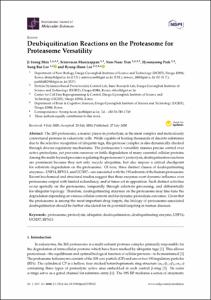Full metadata record
| DC Field | Value | Language |
|---|---|---|
| dc.contributor.author | Shin, Ji Yeong | - |
| dc.contributor.author | Muniyappan, Srinivasan | - |
| dc.contributor.author | Tran, Non-Nuoc | - |
| dc.contributor.author | Park, Hyeonjeong | - |
| dc.contributor.author | Lee, Sung Bae | - |
| dc.contributor.author | Lee, Byung-Hoon | - |
| dc.date.accessioned | 2020-10-26T14:15:26Z | - |
| dc.date.available | 2020-10-26T14:15:26Z | - |
| dc.date.created | 2020-07-31 | - |
| dc.date.issued | 2020-08 | - |
| dc.identifier.issn | 1661-6596 | - |
| dc.identifier.uri | http://hdl.handle.net/20.500.11750/12443 | - |
| dc.description.abstract | The 26S proteasome, a master player in proteolysis, is the most complex and meticulously contextured protease in eukaryotic cells. While capable of hosting thousands of discrete substrates due to the selective recognition of ubiquitin tags, this protease complex is also dynamically checked through diverse regulatory mechanisms. The proteasome’s versatility ensures precise control over active proteolysis, yet prevents runaway or futile degradation of many essential cellular proteins. Among the multi-layered processes regulating the proteasome’s proteolysis, deubiquitination reactions are prominent because they not only recycle ubiquitins, but also impose a critical checkpoint for substrate degradation on the proteasome. Of note, three distinct classes of deubiquitinating enzymes—USP14, RPN11, and UCH37—are associated with the 19S subunits of the human proteasome. Recent biochemical and structural studies suggest that these enzymes exert dynamic influence over proteasome output with limited redundancy, and at times act in opposition. Such distinct activities occur spatially on the proteasome, temporally through substrate processing, and differentially for ubiquitin topology. Therefore, deubiquitinating enzymes on the proteasome may fine-tune the degradation depending on various cellular contexts and for dynamic proteolysis outcomes. Given that the proteasome is among the most important drug targets, the biology of proteasome-associated deubiquitination should be further elucidated for its potential targeting in human diseases. © 2020 by the authors. Licensee MDPI, Basel, Switzerland. | - |
| dc.language | English | - |
| dc.publisher | MDPI AG | - |
| dc.title | Deubiquitination Reactions on the Proteasome for Proteasome Versatility | - |
| dc.type | Article | - |
| dc.identifier.doi | 10.3390/ijms21155312 | - |
| dc.identifier.scopusid | 2-s2.0-85088851275 | - |
| dc.identifier.bibliographicCitation | International Journal of Molecular Sciences, v.21, no.15, pp.5312 - 16 | - |
| dc.description.isOpenAccess | TRUE | - |
| dc.subject.keywordAuthor | ubiquitin | - |
| dc.subject.keywordAuthor | deubiquitination | - |
| dc.subject.keywordAuthor | deubiquitinating enzyme | - |
| dc.subject.keywordAuthor | USP14 | - |
| dc.subject.keywordAuthor | UCH37 | - |
| dc.subject.keywordAuthor | RPN11 | - |
| dc.subject.keywordAuthor | proteasome | - |
| dc.subject.keywordAuthor | proteolysis | - |
| dc.subject.keywordPlus | SUBSTRATE DEGRADATION | - |
| dc.subject.keywordPlus | REVEALS MECHANISMS | - |
| dc.subject.keywordPlus | PROVIDES INSIGHTS | - |
| dc.subject.keywordPlus | STRUCTURAL BASIS | - |
| dc.subject.keywordPlus | RECEPTOR HRPN13 | - |
| dc.subject.keywordPlus | ATAXIA MICE | - |
| dc.subject.keywordPlus | UCH37 | - |
| dc.subject.keywordPlus | UBIQUITINATED PROTEINS ACTIVATE | - |
| dc.subject.keywordPlus | ENZYME USP14 | - |
| dc.subject.keywordPlus | CONFORMATIONAL LANDSCAPE | - |
| dc.citation.endPage | 16 | - |
| dc.citation.number | 15 | - |
| dc.citation.startPage | 5312 | - |
| dc.citation.title | International Journal of Molecular Sciences | - |
| dc.citation.volume | 21 | - |
- Files in This Item:
-
 기타 데이터 / 3.68 MB / Adobe PDF
download
기타 데이터 / 3.68 MB / Adobe PDF
download



